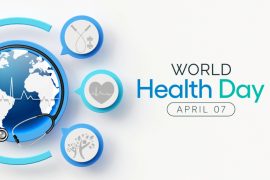World Diabetes Day (WDD) was established in 1991 by the International Diabetes Federation (IDF) and the World Health Organization (WHO) in response to growing concerns about diabetes’s growing health hazards. With the approval of United Nations Resolution 61/225 in 2006, World Diabetes Day became an official United Nations Day. Every year on November 14, the birthday of Sir Frederick Banting, who co-discovered insulin with Charles Best in 1922, is commemorated. WDD is the world’s largest diabetes awareness program, with over 1 billion people in over 160 nations participating. The campaign raises public awareness of issues that are important to the diabetic community and keeps diabetes in the spotlight.
What is Diabetes?
Diabetes mellitus, sometimes known as diabetes, is a metabolic condition marked by high blood sugar levels. Insulin is a hormone that carries sugar from your bloodstream into your cells, where it is stored or used for energy. If you have diabetes, your body either doesn’t produce enough insulin or can’t use the insulin it produces as effectively as it should. If left untreated, diabetes-related high blood sugar can affect your nerves, eyes, kidneys, and other organs. According to IDF Diabetes Atlas in 2019, 463 million adults (1 in 11) were diagnosed with diabetes. By 2030, the number of people with diabetes is predicted to reach 578 million.
Diabetes is divided into several types:
Type 1 Diabetes is an autoimmune illness. The immune system targets and destroys cells in the pancreas, where insulin is created. The exact cause of the attack is unknown. This kind of diabetes affects about 10% of diabetics.
Type 2 Diabetes results due to Sugar build up in your blood as your body develops insulin resistance.
Prediabetes is a condition in which your blood sugar level is greater than usual but not high enough to be diagnosed with type 2 diabetes.
Gestational diabetes is high blood sugar during pregnancy. The production of insulin-blocking chemicals by the placenta causes this type of diabetes.
Diabetes insipidus, despite its similar name, is a rare condition that is unrelated to diabetes mellitus. It’s a different condition in which your kidneys excrete too much fluid from your body.
As per Centres for Diabetes Control and Prevention (CDC), Diabetes patients are also more likely to have factors that raise their risk of heart attack or strokes, such as high blood pressure or high cholesterol. If you have diabetes, controlling your blood glucose, commonly known as blood sugar, can help you protect your heart and health. Controlling your high blood pressure and cholesterol levels might also help you stay safe. If you smoke, seek assistance in quitting.
What is the link between Diabetes and Cardiovascular Diseases?
Diabetes can cause damage to your blood vessels as well as the nerves that control your heart and blood vessels. This damage can lead to heart disease over time. Diabetics are more likely to develop heart disease at a younger age than non-diabetics. Adults with diabetes are about twice as likely as non-diabetic adults to get heart disease or stroke. People with diabetes mellitus have nearly twice the risk of sudden cardiac mortality as those without the disease. Because diabetes is linked to an increased risk of morbidity and mortality, particularly due to a higher risk of concurrent coronary artery disease and congestive heart failure, the link between diabetes mellitus and an increased risk of sudden cardiac mortality may not surprise those who care for patients with diabetes.
Diabetes patients are also more likely to have the following conditions, which increase their risk of heart disease:
- High blood pressure causes the blood to flow more forcefully through your arteries, potentially damaging the arterial walls. Having both high blood pressure and diabetes increases your risk of heart disease significantly.
- Plaque can build on damaged artery walls if you have too much LDL (“bad”) cholesterol in your system.
- High triglycerides (a form of fat found in the blood) and low HDL (“good”) cholesterol or high LDL cholesterol are thought to play a role in artery hardening.
However, it’s crucial to remember that the risk of sudden cardiac mortality in diabetics is linked to a variety of factors other than coronary artery disease and congestive heart failure, and there’s still a lot to learn about the risk factors for sudden cardiac mortality in diabetics that could lead to preventive treatments.



In such situations is BRS (Bioresorbable Scaffold) a boon for younger generation?
Now that it’s evident that heart problems can strike anyone at any age, let’s learn more about angioplasty. It is one of the most popular procedures among those who are at high risk of heart attacks. Bioresorbable stents are the most recent type of coronary stent to be discussed. These stents have the potential to transform cardiology in the same way that bare-metal stents and eventually DES revolutionized cardiology. While it’s tempting to dismiss these devices as a natural response to clinical experience with more traditional stents, it’s worth noting that the notion of bioresorbable stents has been known since the early 2000s, when the first DES was introduced. The essential reasoning for such stents, which was laid out at the time, namely that the stent should vanish once its primary purpose was completed, is still valid today. For starters, the continued presence of polymer and metal elements within the arterial wall may reduce the risk of undesirable clinical outcomes. Second, the vessel may be able to regain crucial functions, such as unrestricted vasomotion, which is critical for blood flow and pressure regulation. Finally, the patient who has been treated is allowed to conduct further diagnostic examinations including MRI. Finally, if revascularization is needed in the future, the stented vessel will be acceptable for the whole range of revascularization methods, which is especially significant for younger adult patients and children. As a result, there has been a lot of work done in business and academics to build bioresorbable scaffolds that will deliver these benefits.
Prevention is better than cure so, take care of your heart.
These lifestyle adjustments can help you manage diabetes and minimize your risk of heart disease or keep it from getting worse:
- Maintain a balanced diet: Increase your intake of fresh fruits and vegetables, as well as lean protein and nutritious carbohydrates. Avoid Trans external Trans-fat by eating fewer processed foods (such as chips, sweets, and fast meals). More water, less sugary drinks, and less alcohol are all good things to do.
- Make an effort to maintain a healthy weight: If you’re overweight, even a small weight loss will help lower your triglycerides and blood sugar levels. For a 200-pound person, modest weight reduction implies losing 5% to 7% of their body weight, or 10 to 14 pounds.
- Get moving: Physical activity increases insulin sensitivity (the hormone that permits cells in your body to utilize blood sugar for energy), which aids with diabetes management. Physical activity also aids blood sugar regulation and reduces the risk of heart disease. Aim for 150 minutes of moderate-intensity physical activity per week, such as brisk walking.
- Keep track of your ABCs:
A: Get a frequent A1C test to track your average blood sugar over two to three months, and try to stay as close to your target range as feasible.
B: Maintain a blood pressure of less than 140/90 mm Hg (or the target your doctor sets).
C: Maintain a healthy cholesterol level.
s: Either quit or don’t start smoking.
To avoid health consequences such as heart disease, work with a diabetes care and education professional. You’ll get support and answers, as well as learn about the most recent developments in diabetes management. Learn how diabetes education can assist you in taking the best possible care of yourself. If you don’t already have a diabetes educator, make sure you seek your doctor for a referral.
Source:
- https://www.healthline.com/health/diabetes
- https://worlddiabetesday.org/about/facts-figures/
- https://www.cdc.gov/diabetes/library/features/diabetes-and-heart.html
- https://www.niddk.nih.gov/health-information/diabetes/overview/preventing-problems/heart-disease-stroke
- https://www.sciencedirect.com/topics/engineering/bioresorbable-stent





Comments are closed.